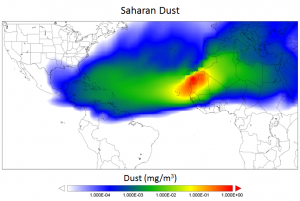General Research Interests:
– Source contributions to atmospheric particulate matter concentrations
– Understanding the final fate of air pollutants
– Improving the science and computational efficiency of air quality models
– Air quality in the developing world
– Atmospheric chemistry modeling across multiple scales
– Inexpensive monitoring approaches to create high resolution monitoring networks
– Enabling community action around local air pollution concerns
Current Projects:
|
|
Global particulate matter source apportionment: We are currently working to implement a source apportionment schema into a global atmospheric model (specifically GEOS-Chem). This work is aimed at providing the atmospheric community with the tools to better track source-specific pollutant transport and transformations at the global scale. While this type of schema is available in regional and local scale models, a full particulate matter source apportionment scheme is not currently available in a global atmospheric chemistry model. This work will allow for a improved estimation of the impacts of long-range pollutant transport on human health, ecosystems, and climate.
Current student: Carmen Lamancusa |
| Modeling over multiple scales: One of the challenges in air pollution modeling is the different scales over which pollutant concentrations can vary, from a plume being emitted by the bus that passes you on the street to large scale intercontinental transport. Our goal is to develop techniques that allow us to model air pollutant concentration gradients efficiently over a variety of scales.
Current student: Fatema Parvez |
|
| Low-cost air pollution monitoring: A variety of low-cost air pollution monitoring sensors have recently been entering the market. In general, these devices are not considered to be particularly accurate but have potential for citizen science applications. We are interested in determining if using the relative values of the sensors might provide information that can be used to evaluate high spatial resolution modeling applications. | |
| Nitrogen deposition to United States watersheds: Air pollution can have a significant impact on watersheds as it deposits on land and water. This project will use air pollutant deposition estimates from the CAMx regional air pollution model in conjunction with watershed classifications from the U.S. Geological Survey to determine watersheds that are in the most danger due to pollutant deposition. |
Completed Projects:
| Region-specific intake fraction estimation: Using the Comprehensive Air Quality Model with Extensions (CAMx) regional air quality model we were able to estimate intake fractions for a wide array of particulate species. Using the Particulate Matter Source Apportionment Technology (PSAT) in CAMx and a new methodology we were able to expand our intake fraction estimates to include secondary particulate matter species.
Team: Carmen Lamancusa Publications: Currently under review. |
